When it comes to restaurant marketing the competition is intense and winning in this area means that you’re going to have to find (and master) a select few marketing tactics that can help you create a dominant presence inside the mind of the market.
In this article I’m going to share 24 great ideas that you can add your your restaurant marketing strategy to help you increase bookings.
Let’s dive in…
1. Google My Business
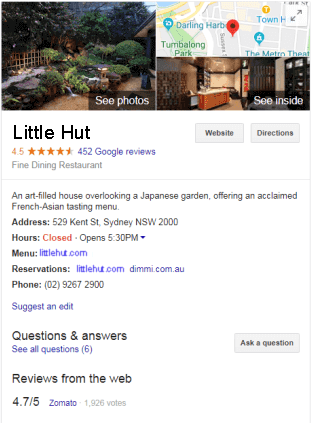
Google My Business (GMB) helps you get listed on Google in your local area, it’s great for driving traffic and it’s also free if you haven’t already set yours up yet here’s a great guide on how to set up your GMB account.
Fill out all the information Google asks for or someone else will fill it out for you – that’s right, anyone (including competitors) can suggest an update to your listing that could actually go live so it’s best that you monitor your listing and keep it updated.
This listing shows important information like opening hours, cuisine, reviews etc.
Follow this quick guide on how to get everything sorted.
Remember add as much content as you can including:
- Latest menu
- Photos
- Opening hours
- Address etc.
2. Food Photos & Videos (build up your marketing assets)
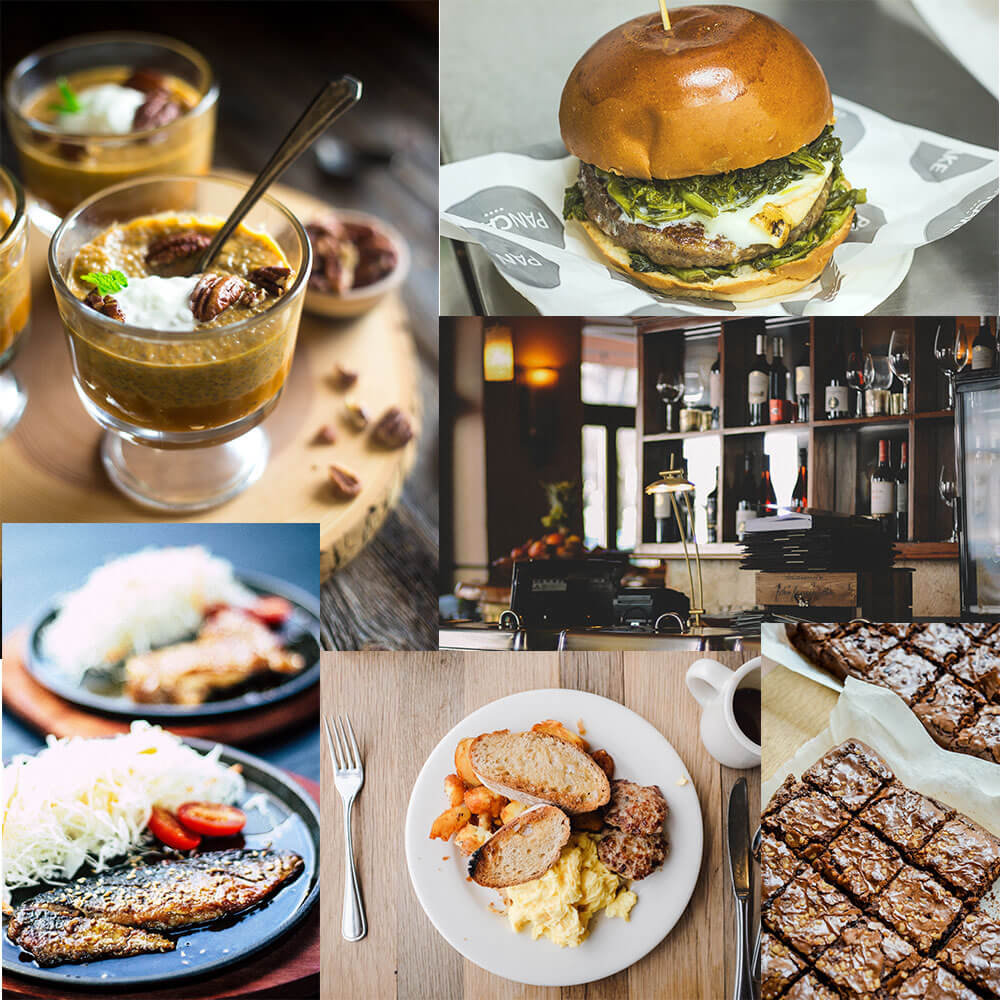 In the restaurant business food shots are your best marketing weapon.
In the restaurant business food shots are your best marketing weapon.
Food photos and videos should be taken often and promoted endlessly on your various media channels (social media, email, websites, flyers etc.).
What should you take photos and videos of?
- Signature dishes
- Everything on your menu (or at least the main items)
- Parts of your process (sourcing, preparation, cooking, serving etc.)
- Your Team
- Festivals or events that you’re involved in
By collecting footage about your restaurant you begin to build an image inside your customer’s mind giving them the feeling that they know you.
Find Different Ways To Promote Yourself
Don’t limit yourself to the food on your menu, create unique, fun and amazing dishes that are designed to stop people in their tracks once they set their eyes on it.
Photos that showcase great food instantly snaps up attention and has a person imagining what that food would taste like and gets the salivation glands working.
3. Instagram – Build A Following
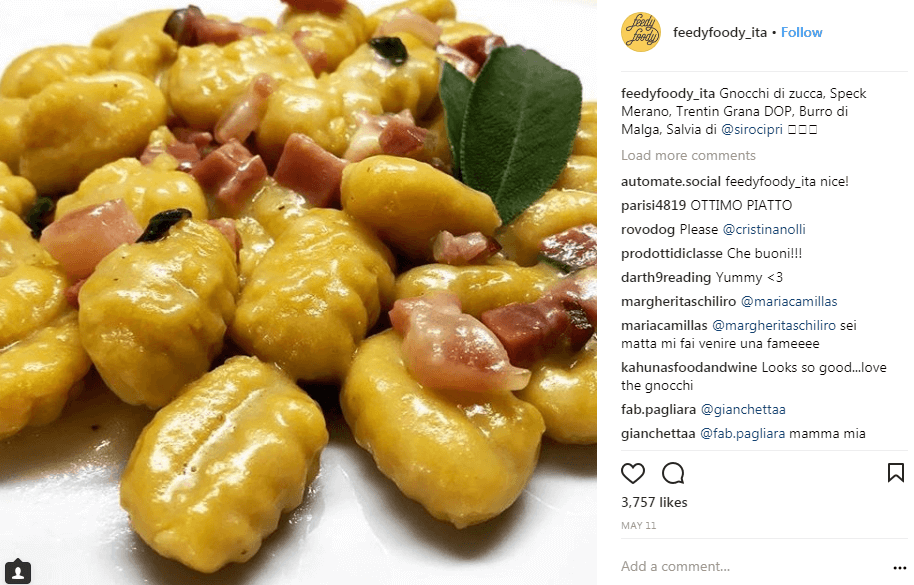 Instagram was practically designed for restaurants due to the highly visual nature of the platform.
Instagram was practically designed for restaurants due to the highly visual nature of the platform.
The goal of Instagram is to build a following of foodies who will actively promote your restaurant with the purpose of creating new customers.
Find Gold Inside Hashtags
Hashtags are basically a way Instagram categorises content and you can use this to get a lot of eyeballs on your foodie shots.
There are two types of hashtags: brand and community.
Brand hashtags are brand related and will be your #RestaurantName this is where you’ll add all of your photos as well as encourage followers to contribute their photos as well for example, contests and giveaways.
Community hashtags are general hashtags that use keywords related to specific interest’s for example #FoodPorn.
Finding Relevant Hashtags
Use the search function inside Instagram to find good potential categories (hashtags) to place your photos into.
Start entering in keywords that are relevant to your business and it will start to auto-populate suggestions.
If you have a keyword list for SEO or PPC ads then this will provide a lot of good ideas.
Find competitors who are killing it on Instagram, look for hashtags that they use consistently.
Use hashtag tools like hashtagify to give you some more ideas.
Don’t use hashtags that have millions of posts, instead look for tags that have 20k – 50k and see how you go but test larger or smaller sizes.
Model & Innovate
Smart restaurants have already gone through the trial and error phase and have now settled on their winning formula – take that formula and innovate on it so you can start benefiting for yourself.
- See how many hashtags they’re using for each post
- See which hashtags they’re using
- See the level of engagement on their post and the hashtags they’ve used
- Look at the types of photos they use – try to look for themes
Stay Close To Your Competition
Like most other social media platforms, Instagram is a great monitoring tool.
Setup an account that you use to follow your competition and also follow restaurants in other cities that are doing well this platform.
This will give you an endless supply of ideas to use for menus, plates, events and marketing ideas.
This is quite tedious at the beginning but Instagram is a good marketing channel and worth mastering.
4. Facebook Post Boosting

For most businesses Facebook just isn’t worth the time and I agree if we’re talking about organic posting.
What is organic posting?
Any post you put on Facebook that you haven’t paid for.
Why has Facebook killed organic posts?
One of the main reasons is that they want to keep their users on the Facebook platform, so if you’re posting free content and asking people to click away you’re competing with them.
They are willing to let you take visitors off their platform if you’re prepared to pay which we’ll to next.
Boosting Posts With Facebook Works Well
A lot of marketers will tell you not to waste your time on boosting posts because it brings in little return and that is true for a lot of businesses but for restaurants I’ve had success with it.
The best part is it is very simple to use.
How To Boost A Post:
- Create a post or select a post you want to promote.
- Click the boost button on the post.
- Select your audience.
- Select your budget (I recommend starting with $5).
- Engage with comments to give the post more legs.
If the post doesn’t gain any traction then kill it and try another post.
If you find a winning post, that is it is getting a good amount of comments and shares then put another $5 behind it to keep it going.
Facebook advertising requires a lot of trial and testing but when you find that winner it can go crazy and expect bookings to fill up fast!
What you’ll find is that the more comments and shares a post gets the more people will chime in and engage in conversation to keep the interaction high – people love it when the Chef or business owner responds to comments.
You should be getting bookings from this promotion as well as a lot of engagement.
Some of the posts that go “viral” are really driven by boosting or paid ads since it is tough to get an organic post to gain momentum.
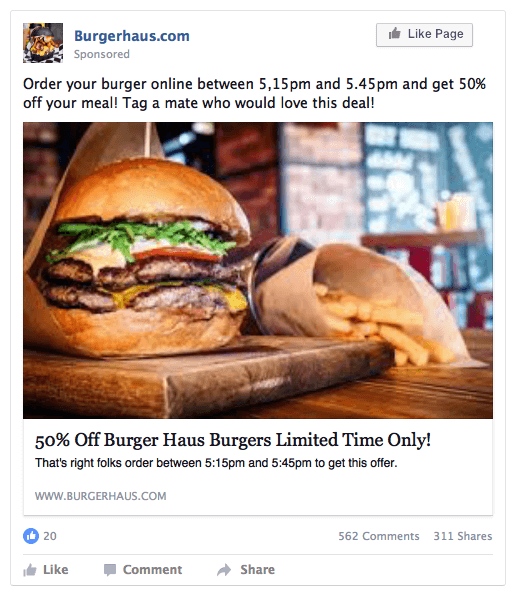
Paid Ads
Facebook ads is an incredibly powerful targeting platform.
If you’re an Italian restaurant you can target people who:
- Love eating out with friends
- Love Italian food
- Enjoy wine
- And live in the immediate areas near your restaurant
You can drill even deeper if you like to find a highly profitable pocket of customers that your competition have not found.
Here is a step-by-step guide on how to launch your first Facebook ads campaign.
Organic Posting
Facebook is considered a “pay to play” platform and as of the time of this article is not recommended for organic posting simply because your reach is effectively zero but it still helps to post images on there just so people can see that you’re active but for organic posting there are better platforms to spend your time on.
Automating Facebook Posts
It is recommended that you use social media management tools to help automate as much of the workload as possible – especially if you’re doing social media yourself.
Hootsuite is a great little tool that allows you to schedule your Facebook posts so you don’t have to be on there every day posting content you can schedule
Also, Meet Edgar is a social media tool that recycles your old posts.
Why would you want to do this? You may have posts that are evergreen (they are relevant today as they were when you took them) these posts should not be forgotten about and should be shown to people who started following you today.
5. Twitter
Twitter is often times overlooked but it shouldn’t be because your customers are on there.
With Twitter you can get your restaurant images, blog posts and offers out quickly and because Twitter is a “fast channel” meaning that content is updated very quickly you can actually post the same post multiple times per day without being seen as spam.
As with all marketing timing is essential.
Again, use a social media management tool like Hootsuite to schedule all of your Twitter posts for the week and then get on with running your business.
Create a post with an image and schedule it to go out at the most opportune times during that day 11am and 4pm for example.
6. Yelp
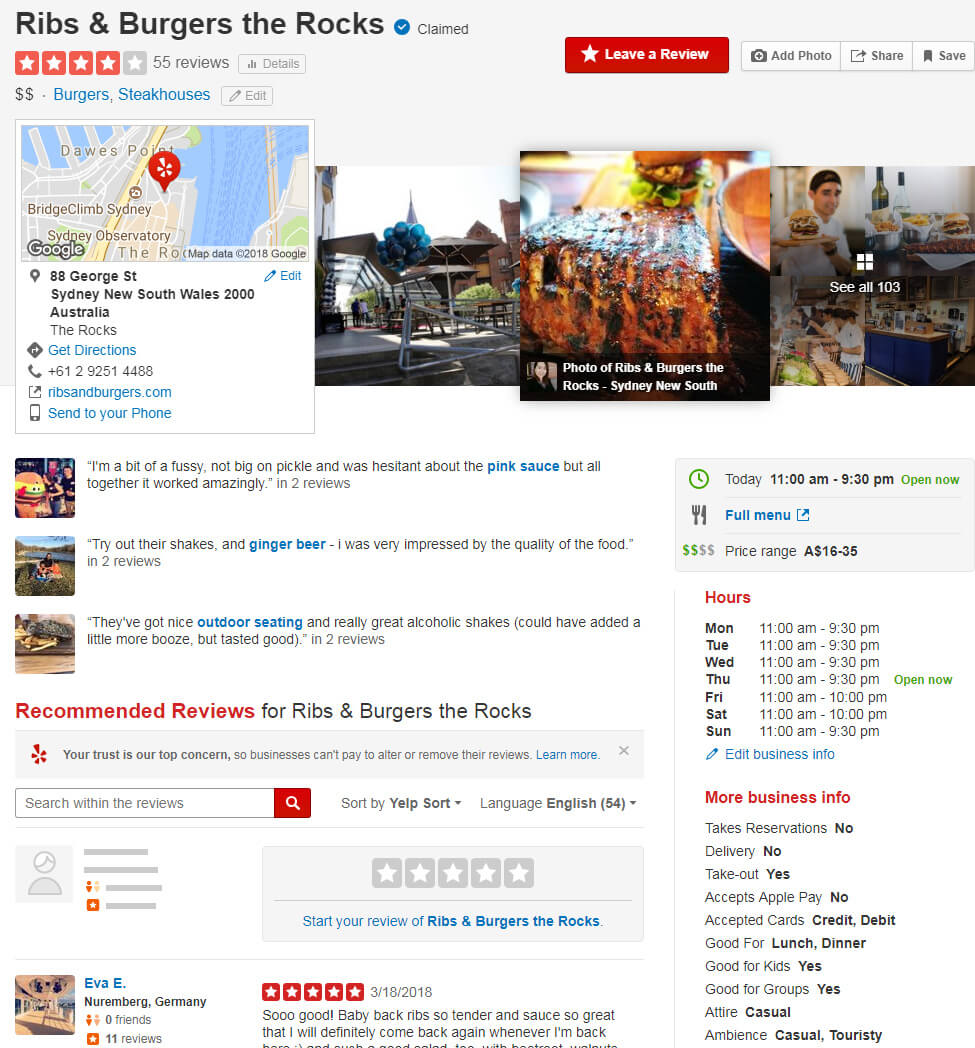 Review sites are essential for any business especially in hospitality.
Review sites are essential for any business especially in hospitality.
Yelp is a directory where customers can leave reviews on businesses that they frequent.
With Yelp you can add all of the necessary information about your restaurant including:
- Opening and closing times
- Photos
- Directions
- Information about your cuisine
If you’re currently receiving great word of mouth from customers then review sites like this become an incredibly powerful marketing tool because they amplify your restaurant and will help you get more customers for your restaurant.
If you don’t have a Yelp page yet, claim it by submitting your business details to show you are the owner.
After you’ve claimed your page, you can respond to reviews and participate in advertising if you choose.
Upload your best photos.
7. Urbanspoon
Reviews are essential for driving traffic to your restaurant and website and although Google displays reviews anyone can get on there and make up a bunch of stuff i.e. give you a bad review just because they’re a competitor of yours – this happens a lot!
Urbanspoon actually have a different process for taking reviews from customers.
Unlike Google, reviewers actually need to build up a reputation before their reviews will be placed at the top this means that the reviews that you see are from genuine food lovers instead of one-off bad customers.
For example, if a competitor of yours decides to go on there to leave a nasty review it will be at the bottom of the review heap because they haven’t developed a reputation yet – whereas Google will place the latest review first.
8. Encourage User-Generated Content
 User generated content is great because it’s like having an endless supply of marketers promoting your business to their friends.
User generated content is great because it’s like having an endless supply of marketers promoting your business to their friends.
People who dine out love nothing more than to see art on a plate so they can take snapshot and fire it off on their favourite social media accounts.
Obviously the food needs to be presented well but it’s important that they have a good time so there’s a story to go along with their photos.
Decide The Rules Of Engagement
Where do you want these photos appearing? What hashtag will be used (if any)? Will they have to wear a Viking helmet in the shot?
Give Prizes For Best Photos
Give away free dinners and other offers when a customer uploads amazing shots of your food. This will give your UGC strategy a good push. This also encourages people to get a little more creative, they’ll be looking to take the best angle and even add props to make the photo even better.
Engage On Submitted Content
It’s always cool to see the business owner take time out to weigh in on a post to give their approval or opinion. Commenting on posts are great for starting a conversation and giving it more legs.
9. Build A Brand People Can Connect To
 People love familiarity and is one of the reasons people come back.
People love familiarity and is one of the reasons people come back.
Creating a vivid image of what your restaurant is about and the people who are in it can create that sense of familiarity before a person has even eaten at your restaurant.
Brand building is far beyond the scope of this guide but a great way to build a personable brand is to showcase your team, product and restaurant.
- Take photos of your team (shoulders and head shot). Create a “Meet Our Team” page and add photos.
- Take in-the-moment photos of your team while they’re working to capture more natural shots.
- Snap photos of your customers enjoying the atmosphere and the food.
- Take photos of the restaurant décor
- If you shop local organic produce then take photos of where you buy your food – this helps to reinforce your image.
Videos Are Great Too!
Videos tend to get high engagement on social media.
- If you’ve got something interesting like a giant cheese wheel take a video of your team opening it up.
- Take videos of signature dishes being prepared
Photos and videos can capture the various characters inside your business and people can connect to characters.
Reinforcing ‘what you are about’ through video and image allows people to connect to that idea, this creates more commitment which helps with customers coming back time and again.
10. Monitor Your Social Media Reputation
If you’re going to be on social media you’re going to have people talking about you which is great but you don’t want to let it get out of control.
Boost Positive PR
If you’re getting lots of great comments, you want to be their commenting and replying to ‘fan the flames’ so you can keep driving that momentum.
Be Proactive With Online Reviews (It’s Free PR)
If you’re getting negative comments you want to act fast and jump on it.
This does a few important things:
- Give you an opportunity to improve your service by identifying recurring problems developing processes to reduce similar issues.
- You can win that customer back by showing you’ve heard them out and are willing to resolve it for them.
- Shows potential customers that you’re a proactive restaurant that cares about its customers.
- Creates PR via online conversations.
Most restaurants won’t go that extra mile and actively monitor their online reputation outside of Google or Yelp reviews which will.
There are tools like Hootsuite, Buzzlogix and Sprout Social that will help you keep your finger firmly planted on the pulse of what people are saying about you to give you the general feel of how the market feels about your brand.
This form of PR is extra work but think of it as an additional marketing channel that you can use to get people talking about you.
11. Spy On Competitors (Or Yourself) With Google Alerts
Google Alerts is a free tool that will send you a daily email on specific keywords that are of interest.
The keywords you should be tracking are your own brand name, your competitors brand names perhaps specific dishes or trends.
It’s Useful For Content Curation (using other peoples content)
It’s also a decent content curation tool, set up keywords that your customers might be interested in and post the best finds on your social media channels, this will save you from having to come up with ideas yourself.
Whatever intelligence you want to stay abreast of you can let Google keep you updated.
12. Optimize Your Website For Maximum Traffic
Your website should be your top marketing tool, think of it as your 24/7 sales rep that will bring in web traffic and turn that traffic into table bookings on autopilot.
This means that your site needs to be:
- Clean: when a person lands on your site you want to have a site that is free from clutter and make it easy for people to take specific actions (see the menu, book a table etc.)
- Easy to navigate: every visitor has a goal that they want to complete and your job is to help them and navigation is an important factor because it helps them find specific information. Keep your navigation as simple as possible and design it in a similar way as other websites so that visitors aren’t fumbling around your site, they know exactly where to go.
- Answer questions: visitors are going to have questions in their mind like “do they have parking?” “where is the menu?” “how do I book a table?” “are there tables left?” “what time to do they open?” etc. so make sure that you have all of the answers on your site.
Ultimately, the job of the restaurant website is to get your phone ringing with hungry customers – that’s it.
Make Your Website User-Friendly
Before a person lands on your website a lot of the times their mind is all over the place – they are thinking about 101 things this is not good for you.
A clean website has a calming effect on a person it has few options available and always has the main call to action (make a booking now) always present.
Here’s a quick example from Bop Design:
On the before version it is quite confusing as what the user should do now look at the redesigned version of their website below, you’ll notice that the option has been simplified with the two largest button on the screen displaying “search jobs” or “find talent”.
They have determined that the majority of people who land on this site want either of these two outcomes.
If the user clicks the top right hand menu then they are presented with more options.
Make your site easy to navigate, build it with their needs in mind and you’ll create a high-performing website.

Optimise These Areas To Improve Website Performance:
- Implement an ongoing SEO strategy
- Create epic content
- Keep your site code clean, compress images, use less plugins to increase loading speeds
- Make sure you have a mobile website (most people are searching for restaurants using mobile search)
- Have a way to collect email addresses
- Include a click to call (when a person touches your phone number it automatically rings your restaurant)
- Include a feature that allows people to book online (not essential however)
13. Use SEO To Move Up In Google Rankings
SEO is incredibly important because it helps people find you – if you can find yourself on the 1st page of Google preferably in position 1-5 then you will notice a dramatic increase in bookings than if you were on page 2+.
According to SEO authority Brian Dean (Backlinko) Google has around 200 ranking factors – but you only need to focus on a few key areas:
- On-Page SEO – this tells the search engines what your site is about.
- Keywords – these are search phrases that a person enters into Google “italian restaurant” .
- Content – video, audio, images and written articles.
- Backlinks – other websites that have a link on their site that points to yours.
- Mobile Optimized Website – a version of your website that fits on a mobile screen.
Help Search Engines Understand Your Website With On-Page SEO
This helps Google understand what you page is about. This is a fairly large subject and beyond the scope of this article however there are plenty of resources online about how to create great on-page SEO.
Check out Neil Patel and Brian Dean (Backlinko) and MOZ for information on on-page SEO.
Find Keywords That Drive Traffic
Keywords are short phrases that you will use to match up with what people are typing into Google (search queries), for example:
- “Italian restaurant”
- ‘Italian restaurant Sydney”
- “best Italian restaurants”
Each of these keywords will have a specific numbers of monthly traffic behind them and your job is to create content based around these keywords in order to cut you off a slice of that traffic.
For example:
Let’s say you have a restaurant in Sydney.
- “Italian restaurant Sydney” has 2,100 monthly searches in Australia.
- “best Italian restaurant Sydney” has 700 monthly searches in Australia.
- “Italian restaurant CBD Sydney CBD” has 350 monthly searches in Australia.
That’s 3,150 people looking for Italian restaurants in Sydney just with these 3 keywords and there are at least 200 more keywords similar to these that will give you even more traffic potential!
Most of the keywords that you use will be the same ones that your close competitors will be using as well and you can use tools like AHREFs to find those keywords and how much traffic they are receiving.
Get Backlinks To Skyrocket Search Rankings
What is a backlink?
When you’re on a website and you click on a link that takes you to a different website that is called a backlink, the site that you are on has linked to another site that it deems valuable.
Think of backlinks as a form of ‘digital voting’ since Google is only a machine it can’t really tell what is valuable content (although it is getting better) so it relies on humans to fill in the gaps.
When a lot of websites link back to another website or specific piece of content, Google assumes that website is valuable and so it pushes it up in rank so that more people can see it.
There are plenty of experts on how to create backlinks, if you do a search for Brian Dean, Neil Patel, MOZ this will give you a good place to start learning how backlinks work and how to create them.
Avoid Future Penalties By Having A Fast Loading Website
Your website needs to load quickly but mobile users are especially intolerant of slow websites so you need to make sure your site takes no longer than 2-3 seconds to load on a mobile device – you can test your website speed here.
Here are 4 ways to increase site speeds:
- Clean code: Websites are made up of coding language and sometimes if not coded correctly can make it hard for the search engines to read and also slow down your site speed.
- Images: You’re going to have a lot of images on your site so it is essential that you compress these down to under 100kb each preferably 50kb in order to do this resize your images so that they’re 800-1200 width this will cut down on the file size quite a lot, next you’ll need to compress the images further using a tools like TinyJPG or if you’re using WordPress using a plugin like WP Smush will help.
- Less Plugins: To many plugins can slow down your website, they can also create website issues and conflicts between other plugins.
- Use A Faster Host Provider: Moving your site over to a faster hosting service like WP Engine (if you’re using WordPress) will improve site speed time. There are plenty of great hosting providers available.
Is Your Site Mobile-Ready?
In 2018 52% of searches are happening on mobile, not only that but smartphone usage is only going up with the U.S. has 237 million smartphone users (2018), Australia has nearly 100% smartphone penetration with currently 88% of the country (2018) owning a smartphone device, New Zealand is already at 100% penetration.
The world is heavily mobile based with customers pulling out their smartphones to find places to eat out.
For this reason it’s important that you have a mobile-ready site.
The image on the left is an example of a site that is not mobile responsive. This is a site that you actually need to zoom in to see the text – not a good experience for a mobile user.
The image on the right is able to neatly get all of the necessary elements onto the mobile screen. Here’s a good example from BentoBox an unoptimised mobile site versus optimised. Notice in the first version the website is crammed into the mobile frame? This is not good for the user experience and as a result could impact your Google rankings.
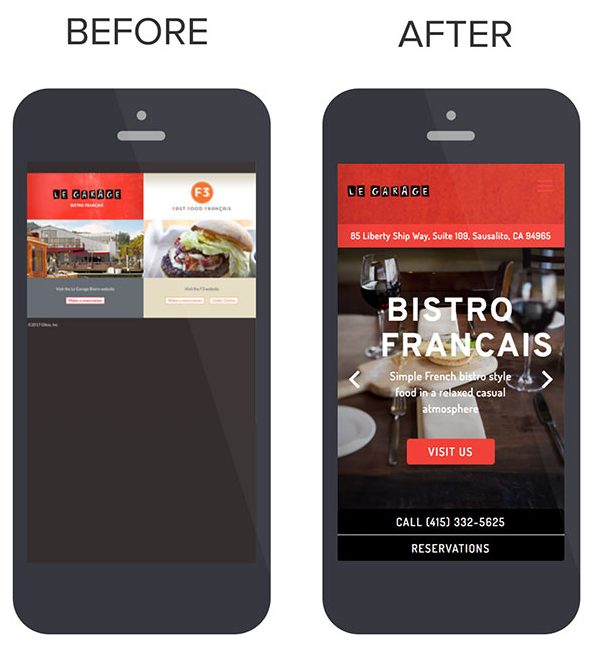
Can People Book Straight From Their Phone?
Make sure that you have a “click to call” function on your mobile site so people can tap your phone number or “make a booking” button and call directly to your restaurant.
14. Local PPC – Search Advertising
PPC is performance-based advertising meaning that you only pay when someone clicks on your ad.
In this case we’re talking about Google AdWords PPC advertising – also known as search engine marketing…
Imagine finishing work late, you’re tired and you want to get home quickly and you think to yourself “I would really love a cab right about now.”
At that exact moment, an empty cab (that doesn’t smell like bad body odour) comes around the corner.
Perfect.
This is how search advertising works.
Someone wants to go out for Italian cuisine, types “Italian cuisine in hampton hills” into a search engine and your ad shows up on that page.
Timing plays a major factor in marketing and there’s no better time than showing up when someone is looking for you.
While generally not as good in terms of conversions as an organic listing, AdWords is great if you’re not on the first page as you will be able to snap up bookings that would have otherwise gone to another restaurant.
To learn how to set up AdWords use this guide.
15. Great Content
People will often make certain assumptions about your business based on what your website looks like and the content inside it.
Used correctly, content will help you get people over the line and have them booking a table.
What kind of content should you have?
- Have fresh new articles that talk about the dishes you have right now not last season.
- Show video teasers of dishes being prepared in the kitchen.
- Show happy customers enjoying your food.
- Have press releases and reviews so visitors can see how good your food is.
16. Use HTML For Your Menu
Your menu is one of your central marketing pieces and should find its way into as many homes, emails and mobile devices as possible!
What I see most restaurants do is that they convert their menu into a PDF which are typically a pain to read on a mobile device.
Instead use HTML to showcase your menu and make sure it is Mobile friendly, not only that but you can make it interactive, like including “book now” button or link that calls your restaurant up.
That said, have a PDF version available for download if they want to store it on their phone or computer.
17. Online Reservation Tools
When someone is on your website and searching your menu they have momentum so if you have a tool they can use to book online it streamlines the entire user-experience.
This isn’t a must-have tool but can be a good option especially for busy nights when the phone is busy and unable to take bookings.
18. Local Community – Stay Active
Getting involved in community projects is great for business any way you look at it.
Take care of the community and they will do the same.
Sponsoring events will give you something to talk about on your marketing channels, and give you a platform to leverage in various ways.
Get involved with local schools and hold cooking classes or offer to update their school menus for example.
Absence does not make the heart grow fonder in business, it makes people forget, so finding ways to stay in the light is a good idea.
19. Food Blogging
 Content creation is incredibly useful for generating traffic, increasing your website rankings/visibility and driving customers.
Content creation is incredibly useful for generating traffic, increasing your website rankings/visibility and driving customers.
If you want to generate traffic through search then you must create delicious content.
Of course this requires time and attention but this does pay off.
There are two food blogging strategies that I recommend:
- Food blogging for your own site
- Food blogging for other peoples sites
Food Blogging On Your Own Site
This is posting food blog posts on your website.
I don’t think you should post because everyone else is doing it.
Since you (or your marketing person) only have a limited number of hours in a day each tactic must deliver on multiple objectives.
For example let’s say you create an article on a relatively low competition keyword like” Fresh semolina pasta recipe”.
By creating various posts on low competition keywords you can overtime dramatically increase site traffic while improving your Google rankings from people backlinking to your content.
Food Blogging On Other Websites
Why would you spend time writing for another website?
- To reach new audiences
- To get new backlinks
- To make new connections
There are plenty of food blog websites that are looking for people to provide content, by giving them your content you can get access to their audience, drive those people back to your website and of course Google will start ranking you higher in search results.
It also gives you an opportunity to make a connection with an influencer, if they have an email list (they will have one) and you have an event, you can shoot them an email to promote your event or special offer to their list of followers or just write more content or maybe add banner ad on their site etc.
20. SMS Marketing
SMS Marketing is overlooked by a lot of restaurant owners which is great for those who do decide to integrate into their overall marketing strategy.
Here is why we recommend SMS marketing:
- Less Competition: You can advertise where there is less (or even zero) competition – inside a customer’s SMS inbox.
- No Internet Required: Unlike mobile marketing (which is largely dependent on the customer being connected online, to send and receive an SMS a customer only needs to be in mobile coverage.
- Effective Reach: Incredibly high open and response rates.
- Affordable: It’s one of the cheapest advertising channels – you can have a person make a booking with you and all it costs is a few cents in messaging costs.
Earlier I mentioned that the job of your website is to generate bookings but what about people who land on your website and didn’t actually make a booking?
This is where SMS Marketing comes in handy!
Include a highly visible space on your site that offers some kind of incentive in exchange for their mobile number, for example:
Text the word FREEVINO to 9999 and get a free bottle of red when you book this week!
Anyone who texts in is automatically added to your SMS list which means whenever you want to drive more bookings just send out an SMS message to your list and watch the bookings come in!
But this is not limited to just your website add this offer to your:
- Social media channels
- Flyers
- Sandwich board
- POS
- On the tables
- If you offer takeaways, include a flyer with the food
Generate bookings on demand
SMS has up to 45% response rate and almost everyone opens an SMS they receive making SMS marketing one of the most effective strategies for generating new customers on demand.
By having a list of customers you don’t need to rely on paid advertising or SEO you can create revenue with the click of a button.
Click here for a Free SMS Trial and start collecting mobile customers.
21. Partnerships
Partnerships are a good way to share resources and get access to each other’s customers further building up your awareness.
Finding local food producers are very popular now and will be well into the future as people become more conscious and weary of mass processed foods.
A restaurant I worked with set up partnerships with local cheese makers, wine makers and a high end butcher and held events which attracted a lot of attention from local foodies as they were able to experience different produce.
Partner Up With Delivery Services
Not everyone wants to eat out but they probably want great food.
By partnering with a delivery service you extend your reach beyond the chairs you have available inside your restaurant.
Insert Marketing Into The Takeaway Package.
If you’re going to give a delivery service a cut of your profits then you need to maximise that opportunity by including special offers to those people.
I have ordered from countless restaurants and I have never received additional marketing to entice me to come in, or join their SMS or email club…nothing.
22. Deal sites
This one is a sore point for most restaurants because many restaurant owners believe that it:
- Devalues your food
- Attracts the cheapest customers
- Crushes your team with orders
- Increases complaints from unsatisfied customers
The list is long and I don’t recommend this option if without a solid strategy in place to further monetize the bookings you get.
Deal sites can still be a fantastic way to create buzz, awareness and also fill up your SMS list with hungry buyers.
Grow your own customer list fast
Big coupon sites are valuable because they have large lists of buyers, by capturing as many of these buyers as you can and placing them into your email or SMS list you are actually using that site to grow your own list of customers.
23. Food Blogger Outreach
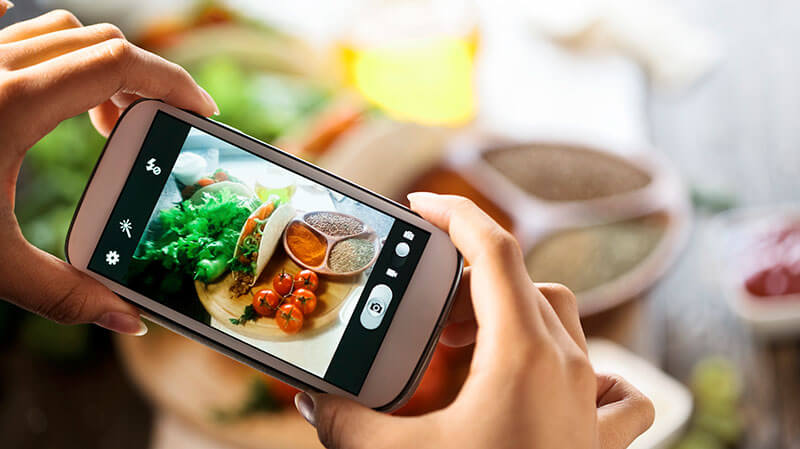 Food blogging is big business and there is no shortage of opportunity to continue to grow awareness around your restaurant and brand.
Food blogging is big business and there is no shortage of opportunity to continue to grow awareness around your restaurant and brand.
Food Bloggers (Influencers)
Leveraging the influence of others is a powerful way to get not only get access to another audience but to piggyback off the influencer’s reputation.
Food bloggers are seen as authorities inside various foodie communities and because of this they are able to command and send traffic to places they recommend.
Start With Smaller Food Bloggers
If you don’t currently have contacts with well-known bloggers, start building relationships with smaller food bloggers because they’re looking for great content to put on their websites and are a lot more open to any offers.
This typically includes a free meal of course.
You do want to make sure that they have:
- A good sized audience on multiple platforms (Instagram, Facebook, Twitter etc.)
- More importantly that audience is engaged (do they get a lot of shares and comments?)
- Do they get comments on their food blogs (this isn’t a deal breaker since most comments will come from the social media channels)
Offer them free dishes to come in and review – you never know if they become popular and grow a large audience they will remember you.
Let them try your signature dishes or dishes that you know will strike a nerve with their audience.
I found it relatively easy to get food bloggers to review the food of a restaurant I was working with – it was a little tedious initially but the payoffs far outweigh .
- Building key relationships.
- Getting access to new groups of potential customers.
- Giving you content to send out on your social media channels.
- Getting backlinks back to your site.
24. Guest Blogger Outreach
Guest blogging means that you will write a piece of content and another website will place it on their website for their audience to see – not only that but you will be able to promote your restaurant (typically in the bio link at the bottom of the article/recipe) and ALSO get a backlink which will boost your rankings.
Guest blogging on a website with a good reputation is one of the best ways to increase your Google rankings.
I’m not going to lie – it is very time consuming, which is why most restaurants won’t do it and Google places a high value on it.
But often times the greatest opportunities in business involve areas where your competitors are unwilling to try.
Guest Blogging The Basic Process
Writing out the entire process is beyond this article but this is basically how it works:
- Find a blog that you’d like to guest post for using Google search (see guest blogger search strings below)
- Review their content and get idea for what their audience likes
- Find a great article that you know their audience will love AND has been proven to get a lot of shares and comments
- Reach out to the blog owner / editor and let them know who you are and give them the idea for a post that you think their audience will love.
- If they like it write your recipe/article – make it unique, put your own twist on it – this is critical.
- Send it back to the blog including your bio, restaurant name and link back to your website
As you can see this is a lengthy process but if you have a marketing person, or are willing to hire someone temporarily to hand this process over to it is well worth the effort!
This needs to be a process, the more relationships you build in the foodie community the more your name gets out there.
Guest Blogger Search Strings
Here are some search queries you can use in Google to find websites that allow guest blogging:
- Keyword + “guest blogger”
- Keyword + “guest post“
- Keyword + “guest article”
- Keyword + “Add Guest Post”
- Keyword + “Submit Guest Post”
- Keyword + “Submit a Guest Article”
- Keyword + “Guest Post Guidelines”
- Keyword + “become a contributor”
- Keyword + “contribute to this site”
- Keyword + “Add Content”
- Keyword + “write for us”
- Keyword + “write for me”
- Keyword + “submit your writing”
- Keyword + “submit article”
- keyword + “inurl:category/guest”
In this example I searched for: food blog “write for us” and it brought up literally hundreds of opportunities:
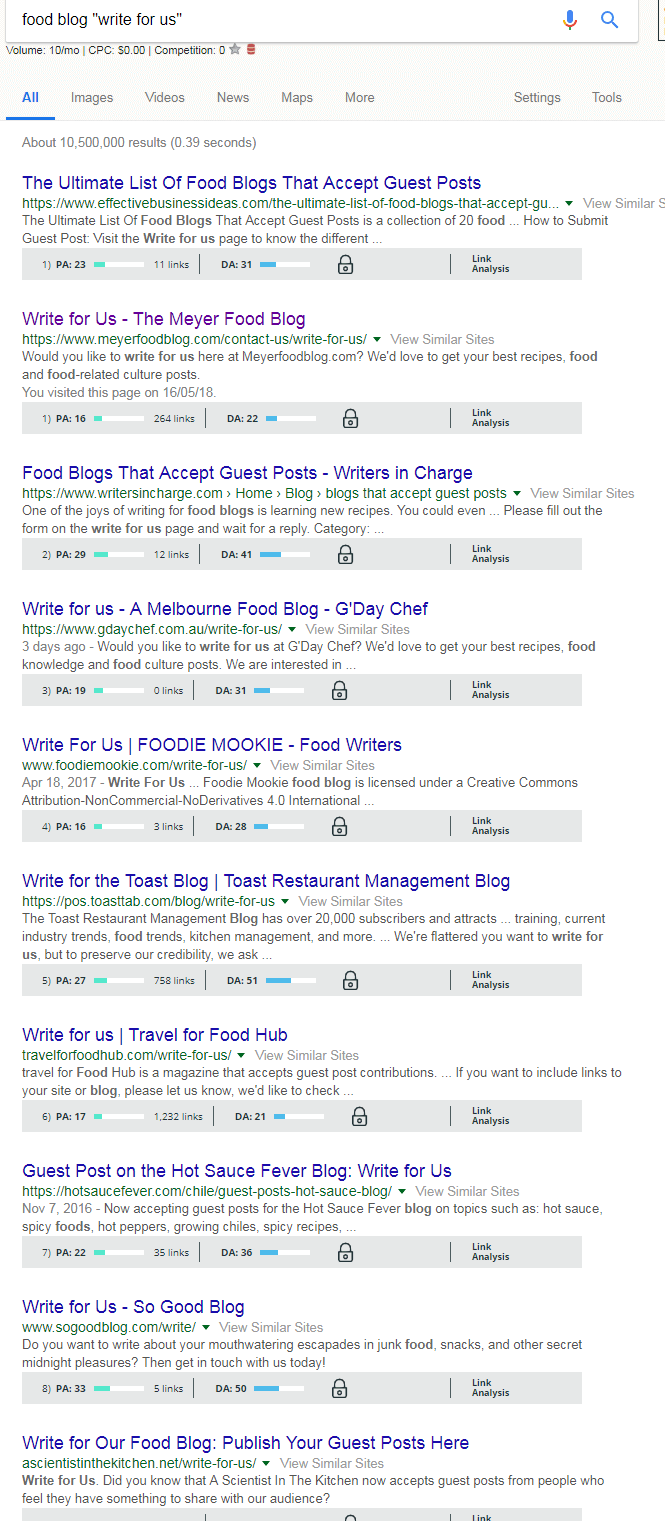
Check the authority of the blog
If you’re going to write for another site you’ll want to make sure that they have a good authority rating with Google.
In the above search example you’ll notice a little bar with a padlock, this is the MOZ SEO toolbar it’s free and plugs in to your browser.
This tool tells you the domain authority of each website, the higher the “DA” number the greater the benefit you’ll receive from having your content on their site.
Check the audience size of the blog
This is not a deal breaker, the DA is more useful, plus you’ll get an idea for the size of the audience by looking at their social media channels but by using a tool like Similar Web you can see how much traffic they’re receiving – this tool is a rough estimate, the traffic is typically more and sometimes it won’t work especially for smaller sites.
What’s most important is that they have an active social media presence with people commenting, sharing etc and that they have a DA 20+
Tools And Resources
Restaurant Guide
I recommend checking out this excellent in-depth restaurant guide, it’s loaded with fantastic restaurant tips & ideas (by the way most restaurateurs never do tip #34 even though it’s one of the core strategies that separates the best restaurants from those that struggle).
- Guest blogging & Outreach: Guest blogging helps you not only improve your Google rankings but also gets you access to other peoples audiences and is one of my favourite strategies.
- Google search: The best tool for finding opportunities to post your advice or recipes.
- Autoklose: Autoklose is a paid tool that allows you to send out hundreds of emails to bloggers and also does the follow up for you so you don’t need to do it one by one. If you’ve got a marketing person they can just use the free options like gmail or outlook etc.
- Moz Toolbar: This is a free tool that will tell you the authority a site has, the more authority the better the opportunity. This is called the DA rating, you want to look for sites that are at least DA 20+.
Web Platform
- WordPress – this is the best web platform in my opinion.
A lot of people are using Wix but I’ve heard it is not that good for SEO – I’ve used WordPress for years and it is an easy platform and is Google likes it.
Lead Capture Plugins
- Thrive leads: Thrive leads is a paid wordpress plugin that can capture leads.
- SumoMe: A free tool that can be used with wordpress.
- OptinMonster: This is another popular paid lead capture plugin for wordpress.
List Marketing Tools
There are plenty of email platforms to choose from but these two are the best to start with.
- Mailchimp: Mailchimp is one of the most popular email automation programs and is incredibly easy to use.
- Campaign monitor: Another great email platform has more features but is a little more complex than Mailchimp.
SMS Platform
Generating customers on demand helps you turn slow nights into highly profitable ones and SMS is an incredibly effective tool here.
Email is a good channel but it does fall down in terms of open rates (how many people see and then open your email) SMS on the other hand virtually guarantees everyone will see your text message and you can expect anywhere from 20-45% response rate depending on the offer.
If you’re interested in a free trial you can so here.
It only takes a few seconds to sign up and you can start sending a few SMS messages to see how it all works.
